DACF Home → Bureaus & Programs → Maine Natural Areas Program → Communities, Plants, and Animals → Invasive Plants → Japanese honeysuckle
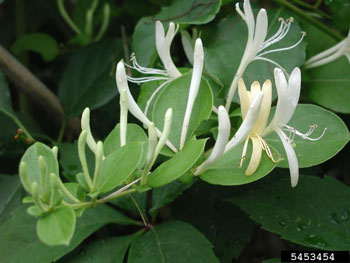 Japanese honeysuckle, Leslie J. Mehrhoff, University of Connecticut, Bugwood.org
Japanese honeysuckle, Leslie J. Mehrhoff, University of Connecticut, Bugwood.org
Japanese Honeysuckle
Lonicera japonica
2019 Status in Maine: Localized. Severely Invasive.
Description: Perennial woody vine; grows in a dense tangle over ground and atop other vegetation. Young stems have fine hairs. Leaves: Leaves are simple, 1½-3½" long, oval, and opposite. Occasionally, leaves low on the vine may have rounded lobes. Leaves appear early and remain late in the season, providing a photosynthetic advantage. Flowers: Tubular, fragrant, 1- 1½" long, creamy white to yellow, with two reflexed lips and long stamens. Occur in pairs between leaves and appear May-June. Fruit: Black berries ripening in fall.
Native range: Eastern Asia. How arrived in U.S.: As an ornamental; also for erosion control and wildlife cover.
Reproduction: By seed and vegetatively. Fruits are eaten by birds and other wildlife and dispersed in droppings. Spreads vegetatively by underground rhizomes and above ground runners.
Habitat: Disturbed areas such as roadsides, field edges, and floodplains. Windthrows, logging, and insect outbreaks provide entry into woodlands. Tolerates shade, but flowering is diminished. Prefers moist soils. Warmer winters and increased atmospheric carbon dioxide levels may aid in its spread northward.
Similar native species: Wild honeysuckle (Lonicera dioica), a rare species in Maine, has hairless vines and perfoliate leaves at the vine tip.
Similar non-native species: Trumpet honeysuckle (Lonicera sempervirens), a native species of southern New England and the southeast U.S., has hairless vines and perfoliate leaves at the vine tip. Young shrubby honeysuckles could also be mistaken for the vine.
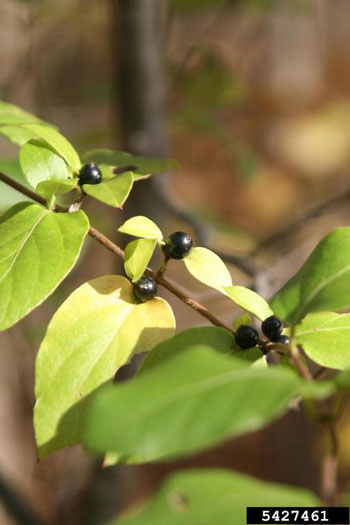 Japanese honeysuckle fruit, Chris Evans, University of Illinois, Bugwood.org
Japanese honeysuckle fruit, Chris Evans, University of Illinois, Bugwood.org
Fact Sheets and Identification Links
- Herndon Environmental Network, Virginia (4:42), Identification video (first half of video)
- Penn State Extension Fact Sheet for Japanese Honeysuckle
- Go Botany page for Lonicera japonica
Control Methods
Hand pull or dig seedlings. If pulling mature plants, consider bagging vines with berries to prevent spreading seed*. Because it holds its leaves into fall, a late season foliar glyphosate solution† can be applied when surrounding plant species are dormant. A glyphosate or triclopyr solution can be applied to cut stems outside of early spring, as long as ground is not frozen.
* Correctly dispose of all plant parts↵ † Follow all label directions when using herbicides↵Control Technique Video Demonstrations
- Herndon Environmental Network, Virginia (4:42), hand pulling, herbicides, mowing, native alternatives (second half of video)
Please email invasives.mnap@maine.gov if you have questions about invasive species in Maine
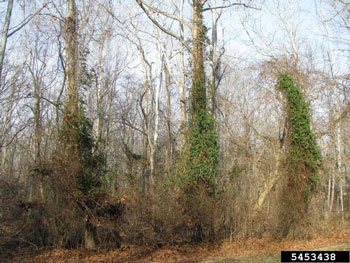 Japanese honeysuckle infestation, Leslie J. Mehrhoff, University of Connecticut, Bugwood.org
Japanese honeysuckle infestation, Leslie J. Mehrhoff, University of Connecticut, Bugwood.org
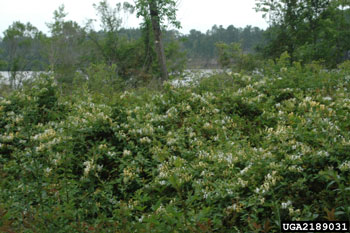 Japanese honeysuckle infestation, Chris Evans, University of Illinois, Bugwood.org
Japanese honeysuckle infestation, Chris Evans, University of Illinois, Bugwood.org
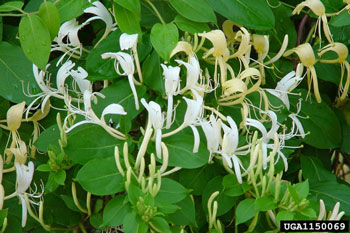 Japanese honeysuckle, Chuck Bargeron, University of Georgia, Bugwood.org
Japanese honeysuckle, Chuck Bargeron, University of Georgia, Bugwood.org
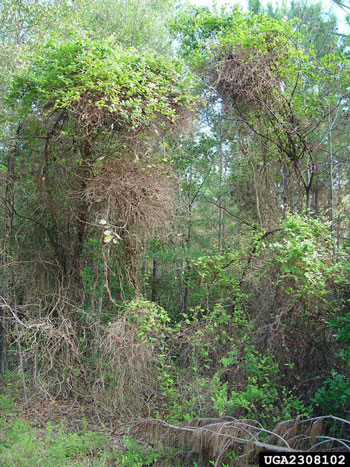 Japanese honeysuckle infestation, Chuck Bargeron, University of Georgia, Bugwood.org
Japanese honeysuckle infestation, Chuck Bargeron, University of Georgia, Bugwood.org